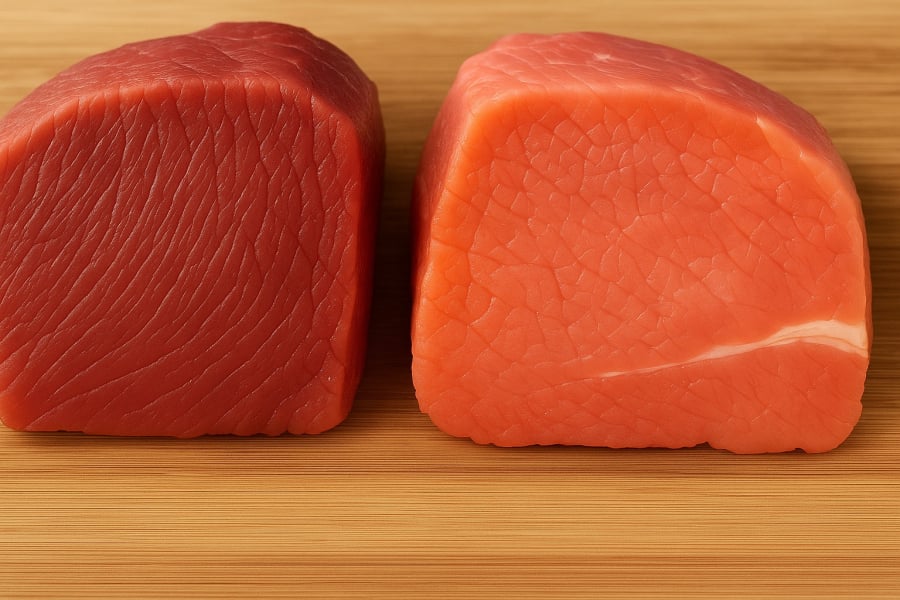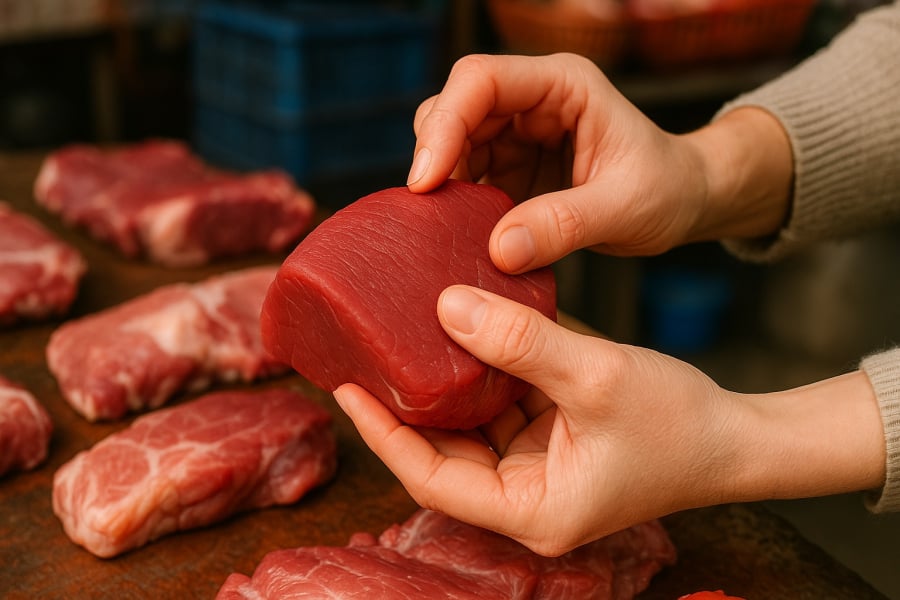Color and Texture: Observe Carefully, Don’t Be Fooled
Authentic beef is typically bright or dark red, depending on the cut and freshness. It’s characterized by fine, long, and smooth muscle fibers with interspersed fat that is light yellow. In contrast, pork usually has larger and shorter muscle fibers with opaque white fat.
Unscrupulous vendors may use red dye, caramel coloring, or other chemicals to transform pork into beef. Often, the coloring is uneven, with some parts darker than others, and the surface may appear slightly shiny due to the dye.
“My years of experience selling meat allow me to instantly recognize genuine products,” says Ms. H.T.H, a long-time meat vendor at Ha Dong Market in Hanoi. “Customers should observe the color and texture of the meat. If the fat is yellow, the texture is fine and consistent, then it’s likely beef. On the contrary, if the fat is white and the muscle fibers are large, it’s probably pork.”

Feel the Meat: Springy and Sticky for Real Beef
Another simple trick to distinguish between real and fake beef is to touch the surface of the meat. When lightly pressed, authentic beef feels dry, springy, and slightly sticky. In contrast, dyed pork tends to be soft, crumbly, and not sticky, with a slimy texture due to the absorption of dye.
A clear sign of dyed meat is when you rub your finger on the surface and notice red residue or an unusual smell. Stay away from such meat to protect your health.
Smell: Your Nose Knows
Genuine beef has a distinctive, strong odor that persists even after cooking. This smell is challenging to replicate, even with the addition of beef fat or chemicals. While fake beef may be scented initially, the smell will eventually fade or turn strange, unlike authentic beef.
When cooked, real beef retains its savory aroma and sweet taste. In contrast, fake beef tends to have a fishy smell, a bland taste, and often turns pale white—a sign of chemical treatment.

Cooking Reveals the Truth
During cooking, if the beef remains pink or takes on a reddish-brown color, with firm muscle fibers and minimal shrinkage, it’s likely authentic. Conversely, if it turns grayish-white, releases water, and has a bland taste, you may have purchased fake beef.
A simple test is to grill the meat directly over charcoal or in a hot pan without oil. Real beef will emit a distinctive aroma, while fake beef often lacks this fragrance and is prone to burning due to chemical treatment.
Where to Buy with Confidence
Even with these tricks up your sleeve, the key to confidence is buying from reputable sources. Opt for supermarkets, clean food stores, or well-known meat stalls in the market—places where vendors allow customers to inspect, touch, and closely examine the meat.
Avoid purchasing from street vendors or unknown sources, as these are more likely to sell unhygienic or chemically treated meat.
In Conclusion
Choosing fresh and delicious beef not only enhances your meals but also ensures the health and well-being of your family. With these tips and insights from experienced vendors, you can become a savvy consumer who confidently navigates the market and cooks with peace of mind.


































